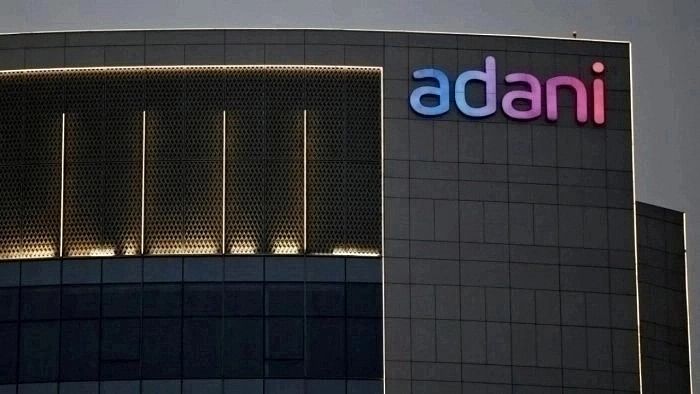
Adani Group logo.
Credit: Reuters File Photo
New Delhi: Billionaire Gautam Adani's group will invest $100 billion (Rs 8.33 lakh crore) in green energy transition over the next 10 years across its ports, power and cement operations as it aims to become a net zero emitter by 2050.
The conglomerate is expanding its renewable portfolio to 45 gigawatts (GW) as well as building three giga factories to manufacture solar panels, wind turbines and hydrogen electrolysers, the Adani group said in a statement.
"The portfolio companies will be investing $100 billion over the next decade towards achieving energy transition," it said.
The group has set a target to become net zero by 2050 or earlier for five of its portfolio companies— renewable energy firm Adani Green Energy Ltd, power transmission utility Adani Energy Solutions Ltd, ports firm Adani Ports & SEZ Ltd, and cement makers ACC and Ambuja Cements.
The portfolio businesses are actively sourcing renewables, electrifying operations and adopting biofuels, and deploying waste heat recovery and energy storage technologies.
The road map to net zero transition will require last mile green hydrogen solutions, Adani Group said, adding its businesses have started pilot projects such as development of hydrogen fuel cell electric trucks as part of the switch.
Detailing the decarbonisation pathway, the apples-to-airport conglomerate said it is looking to cut Scope-1 emissions by electrification of operations where possible, and adopting green hydrogen and its derivatives (green ammonia) for energy storage, heat and mobility where electrification is not possible.
Scope-2 emissions would be cut through sourcing renewable electricity and deployment of waste heat recovery and energy storage technologies such as batteries and hydrogen.
The Group's statement further read, "Adani Group plans to invest $100 billion in energy transition over the next decade, with 70 per cent of the investments earmarked for clean energy."
It is building giga factories to make 10 GW solar panels, 10 GW of wind turbines and 5 GW hydrogen electrolysers.
"Adani's renewables portfolio is expanding to 45 GW, which would be able to commercialise 3 million tonnes per annum of green hydrogen," per the statemen.
Group chairman Gautam Adani had in recent days shared details of the green investments.
"Our commitment to achieving 45 GW of renewable energy by 2030 initiative will help cut annual emissions by an amount equivalent to 80 million tonnes of CO2," he said in a post on X, formerly Twitter.
This reduction would be comparable to eliminating the emissions from petrol cars driving 480 billion km each year!
"Additionally, leveraging one of the world's largest industrial clouds, powered by Google, will help reduce an extra 3 million tonnes of CO2 annually. Over the 25-year lifespan of our renewable farms, these cumulative CO2 savings will be exponentially magnified," the Group said.
Starting off as a commodity trader in 1988, the Adani group has over the years diversified into sea ports, producing coal, energy distribution, airports, data centres and more recently into cement and copper. It even bid and acquired 5G telecom spectrum to set up a private network.
While flagship Adani Enterprises Ltd incubates and develops new businesses spanning mining, airports, defence and aerospace, solar manufacturing, roads, metro and rail, data centres and resource management; Adani Green Energy Ltd— one of the world's largest solar power developers— is targeting 45 GW of renewable energy capacity by 2030.
Its ports business is also on a greening drive.
"By 2025, we will set a national benchmark being the only carbon-neutral port operations and be net zero for APSEZ by 2040. Our climate-friendly transformation includes electrifying all cranes, switching all diesel-based internal transfer vehicles to battery-based ITVs, and installing an additional 1000 MW of captive renewable capacity," Adani said in a post on X.
Adani Ports and Special Economic Zone is the nation's largest seaport operator in the country, with ports on both east and west coasts.
He said Adani Total Gas Ltd (ATGL) — the group's city gas firm is on a 'massive expansion' with "CNG and piped natural gas, compressed biogas, and e-mobility".
ATGL retails CNG to automobiles and piped natural gas to households for cooking and industries across several cities in the country. Alongside this, it is setting up electric vehicle (EV) charging stations as well as building plants that will turn agri waste into gas that can be used in city gas operations.
"We are on target for installing 75,000 EV charging stations by 2030. All of our own 50 sites are now powered by rooftop solar panels. Our operations vehicle fleet, covering 37 million km yearly, completely switched from diesel to CNG," Adani said.
Adani Group ventured into the airport business in 2019, after it won operation and management contracts for six airports of Ahmedabad, Lucknow, Mangaluru, Jaipur, Guwahati and Thiruvananthapuram. Besides, it holds 73 per cent of Mumbai International Airport Ltd, which, in turn, holds 74 per cent of Navi Mumbai International Airport Ltd.
"Adani's #MumbaiAirport is redefining excellence in aviation! It's now the best in Asia Pacific for Services according to ASQ, in the 40 million+ passenger category," the chairman said in a separate post.
On the cement business, he said Ambuja and ACC are leading a sustainable revolution in the cement industry.
"Over 90 per cent of our cement production is now blended cement recycling waste fly ash and slag. This significant shift not only enhances the environmental footprint of our cement but also marks a substantial step towards sustainability."
Adani further said, "Additionally, we are committed to powering 60 per cent of our cement production with renewable energy sources by 2028. This ambitious goal will establish us as a frontrunner in the global arena of sustainable cement production."
Adani said the group is "committed to plant 100 million trees by 2030, one of the most ambitious pledges by an Indian corporate globally. Already at 29 million, we continue to give our best for enhancing biodiversity, climate resilience, and rural livelihoods. Our goal: 37 million mangroves on India's coasts and 63 million inland trees."